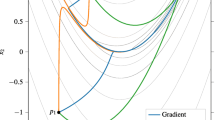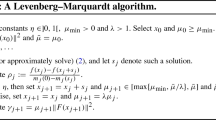Abstract
An approach is described to the numerical solution of order conditions for Runge–Kutta methods whose solutions evolve on a given manifold. This approach is based on least squares minimization using the Levenberg–Marquardt algorithm. Methods of order four and five are constructed and numerical experiments are presented which confirm that the derived methods have the expected order of accuracy.
Similar content being viewed by others
References
V.I. Arnold, Mathematical Methods of Classical Mechanics (Springer, New York, 1989).
M.P. Calvo, A. Iserles and A. Zanna, Numerical solution of isospectral flows, Math. Comp. 66(1997) 1461–1486.
P.E. Crouch and R. Grossman, Numerical integration of ordinary differential equations on manifolds, J. Nonlinear Sci. 3(1993) 1–33.
P.E. Crouch and Y. Yan, On the numerical integration of the rolling ball equations using geometrically exact algorithms, Mech. Struct. Mach. 23(1995) 257–272.
P.E. Crouch, Y. Yan and R. Grossman, On the numerical integration of the dynamic attitude equations, manuscript.
J.E. Dennis, Jr. and R.B. Schnabel, Numerical Methods for Unconstrained Optimization and Nonlinear Equations, Classics in Applied Mathematics (SIAM, Philadelphia, 1996).
L. Dieci, R.D. Russel and E.S. Van Vleck, Unitary integrators and application to continuous orthonormalization techniques, SIAM J. Numer. Anal. 31(1994) 261–281.
K. Engø and A. Marthinsen, Modeling and solution of some mechanical problems on Lie groups, Multibody System Dynamics 2(1998) 71–88.
C. Führer and B.J. Leimkuhler, Numerical solution of differential–algebraic equations for constrained mechanical motion, Numer. Math. 59(1991) 55–69.
H. Munthe-Kaas, Lie–Butcher theory for Runge–Kutta methods, BIT 35(1995) 572–587.
H. Munthe-Kaas, Runge–Kutta methods on Lie groups, BIT 38(1998) 90–110.
H. Munthe-Kaas, High order Runge–Kutta methods on manifolds, Appl. Numer. Math. 29(1999) 115–127.
B. Owren and A. Marthinsen, Runge–Kutta methods adapted to manifolds and based on rigid frames, BIT 39(1999) 116–142.
B. Owren and B. Welfert, The Newton iteration on Lie groups, BIT 40(2000) 121–145.
W.C. Rheinboldt, Differential–algebraic systems as differential equations on manifolds, Math. Comp. 43(1984) 473–482.
J.M. Sanz-Serna and M.P. Calvo, Numerical Hamiltonian Problems, (Chapman & Hall, London/New York, 1994).
J.C. Simo and K.K. Wong, Unconditionally stable algorithms for rigid body dynamics that exactly preserve energy and momentum, Internat. J. Numer. Methods Engrg. 31(1991) 19–52.
S. Tracogna and B. Welfert, Notes on riffle shuffles, manuscript.
Author information
Authors and Affiliations
Rights and permissions
About this article
Cite this article
Jackiewicz, Z., Marthinsen, A. & Owren, B. Construction of Runge–Kutta methods of Crouch–Grossman type of high order. Advances in Computational Mathematics 13, 405–415 (2000). https://doi.org/10.1023/A:1016645730465
Issue Date:
DOI: https://doi.org/10.1023/A:1016645730465




